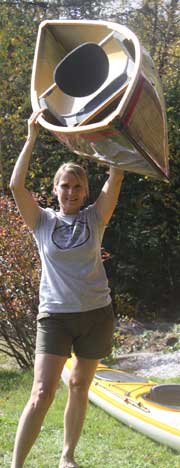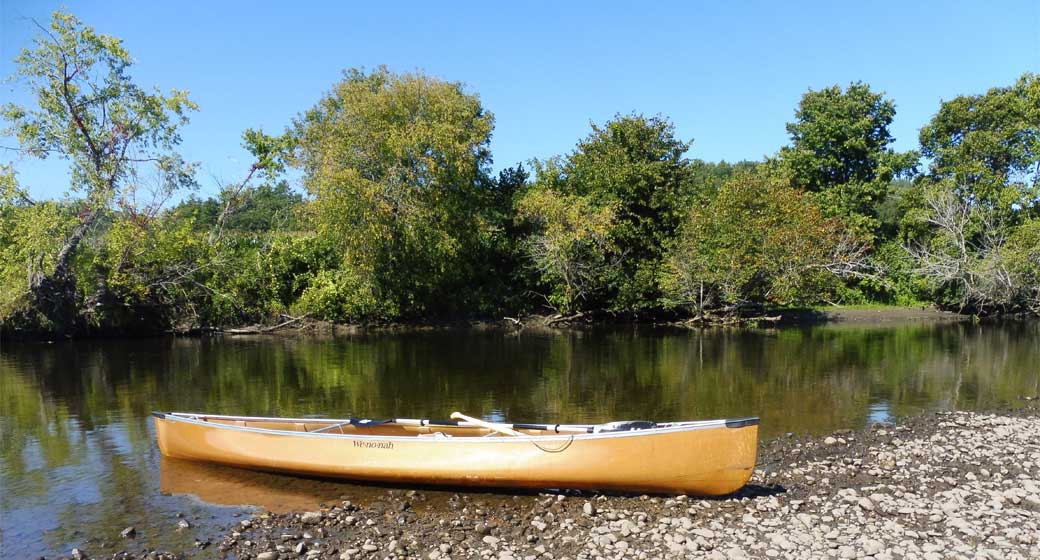




![]() Ultralight boats!
Ultralight boats!
Bent Shaft Paddles
In an article last summer discussing paddles, I briefly mentioned the bent shaft design, promising to expound on it at a later date. Well that time has arrived.
The advantage of this type of paddle is speed and efficiency and as far as I am concerned these two items are inseparable. When you combine them with the "sit and switch" paddling style you have the ultimate in speed and performance. The concept is very simple and I'll do my best to keep it that way when I explain it.
First lets look at the paddle. A bent shaft paddle is simply that, the shaft is bent forward at the point where the blade and shaft meet. The angle of bend varies anywhere from 15 degrees down to 8 degrees the most common being 14. The larger the angle, the more efficient the paddle. Having the shaft bent allows the paddler to keep the blade perpendicular in the water throughout the stroke which means all of your effort goes toward making the canoe go forward. In contrast, when using a straight shaft paddle (unless you are a contortionist) you will not be able to do this. Instead you will be pushing down on the water at the beginning of your stroke causing the bow to rise up and at the end of your stroke you will be pulling up on the water pushing the stern down. The faster and harder you paddle, the more obvious this porposing effect becomes. It doesn't sound like much but over the long haul it really makes a difference. Remember you are the power source, not a Mercury outboard, and your fuel supply is limited, why waste it going up and down instead of straight ahead.
There are some pretty obvious differences between a bent and straight shaft paddle other than the bend. The first thing you will pick up on literally, is the weight. Because the bulk of bent shaft paddles are used in high performance paddling which requires a quick stroke rate, they are made light and following suit, as the weight goes down the price goes up. The overall length you will use tends to be shorter (due to the bend and a shorter blade), and the blades are generally wider, usually 8" or more.
You can use either type of paddle in any kind of paddling conditions. There are however, pro's and con's to both depending on your point of view. For me, well I use both kinds of paddles, which one is determined by what type of canoeing I will be doing. Most of the time I use a bent shaft paddle simply because most of the time I am out to cover a long distance in a hurry. The paddle I use is a 54", 9 ounce graphite model with a 14 degree bend made by Barton Paddle Company. If I plan to go fishing or poking around in a swamp somewhere I will use a straight shaft paddle because they are quieter and easier to perform a variety of strokes with. Here I will use a traditional beaver tail shaped paddle that I make myself. The length will range from 58" up to 72" depending upon whether I am sitting or standing. One thing I should mention is that a bent shaft paddle has only one power face. By this I mean only one side of the blade can be used to paddle with. When held in your hands it will generally orient itself nicely with the bend pointing forward toward your direction of travel. If it doesn't you will notice in a hurry as the porposing effect talked about earlier will be greatly increased.
Paddling with your bent shaft paddle is done the same way you would with a straight shaft paddle. If you read the articles on technique published on 8/27 and 9/10/93 you should be all set. I would strongly suggest you learn the "sit and switch" method over the J-stroke. This will allow you to enjoy the full performance benefits of your funny looking paddles. The key things to remember are to apply the power with your back, shoulder, and stomach muscles. Rotate your shoulders through the stroke so they end up parallel to the side of the canoe as the paddle reaches your hip. Just remember you have only one power face and make sure you know which one it is. You will look pretty silly paddling with the back side of the paddle along with creating alot of extra work for yourself. To keep the canoe going straight paddle on opposite sides and switch sides as required to compensate for the extra leverage the stern paddler has. This will happen every 5 - 10 strokes. It is important that both paddlers switch in unison. To do this someone needs to give the command to switch. The best person for the job is the stern paddler because from this position you can watch the bow paddler and follow their move once the command is given. It's best to keep the command simple, the most widely used word is "hut". When the stern paddler feels the canoe begin to drift off line simply shout "hut" at the beginning of the next stroke. When the bow paddler finishes that stroke you both switch sides together. It may seem a little awkward at first but with practice you will soon find yourself cruising along covering more territory with less effort then ever before. Happy Paddling!

Have a question? I'm happy to answer it - just email me at hpcanoes@gmail.com
![]()
hpcanoes@gmail.com
603.667.5112

We specialize in ultralight solutions and offer expertise in canoes and Wee Lassie boats, as well as all the related equipment. Our favorites are Wenonah canoes and Wee Lassie boats. Although we will work with any material we like to get folks set up with lightweight canoes so you can dedicate your time to the joy of being out on the lakes and rivers instead of struggling to move your boat between car and water.
Scott Edwards, "Hemlock Pete" himself, offers you decades of paddling expertise. He is friendly, down-to-earth, and provides superior customer service. You won't find a better, or more pleasant, deal elsewhere.

